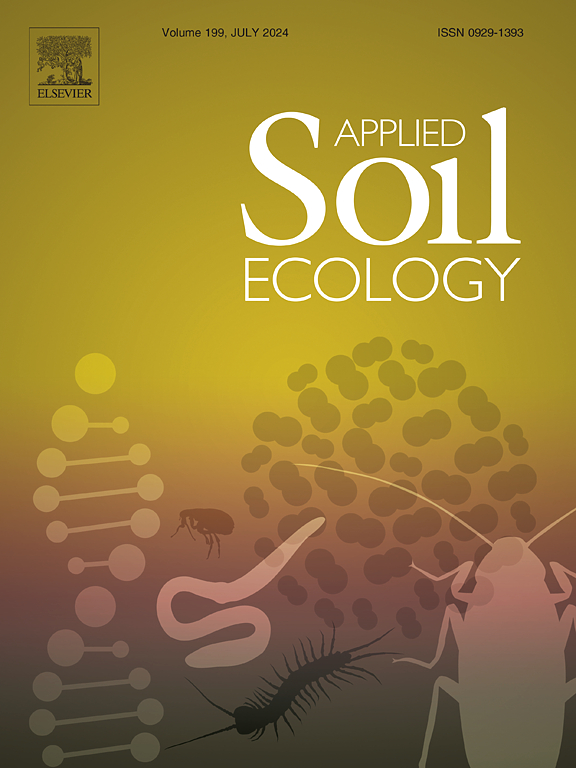Phosphate-cycling activity of the soil microbiome in response to the recycled phosphates struvite and vivianite
IF 4.8
2区 农林科学
Q1 SOIL SCIENCE
引用次数: 0
Abstract
Recycling phosphorus from waste streams is crucial for meeting rising fertilizer demands without depleting finite resources. Struvite and vivianite, recovered from wastewater treatment processes, have demonstrated potential as fertilizers. However, the impacts of these recycled phosphates on soil microbial communities, particularly those involved in phosphate cycling and their potential to solubilize struvite and vivianite, are poorly understood. This study examined the effects of struvite and vivianite amendments on soil microbial community composition and activity across diverse management regimes using soil incubation. The microbial community was assessed by 16S rRNA gene and ITS amplicon sequencing, and the phosphate-cycling capacity of the soil microbial communities was assessed via phosphatase activity and solubilization assays targeting inorganic phosphates, including tricalcium phosphate, struvite and vivianite. While the overall composition of the soil microbial community remained largely unchanged following recycled phosphate amendment, specific microbial taxa were enriched, reflecting the chemical properties of the amendments. Struvite application resulted in the enrichment of Nitrosospira and Nitrospira populations, while vivianite amendment favored Streptomyces and Mortierella. Despite these taxa-specific enrichments, all phosphate-cycling activity remained stable following vivianite amendment across all soil management types. Struvite amended soils exhibited a soil-specific dip in phosphate solubilization activity at the beginning of the experiment, but all phosphate-cycling activities were unchanged at the end of the soil incubation. These findings indicate that, independently of soil management regime, struvite and vivianite amendments maintain stable phosphate-cycling activity within soil microbial communities.

土壤微生物群对再生磷酸盐鸟粪石和活钙石的磷素循环活性响应
从废物流中回收磷对于在不耗尽有限资源的情况下满足不断增长的肥料需求至关重要。从废水处理过程中回收的鸟粪石和橄榄石已显示出作为肥料的潜力。然而,这些再循环磷酸盐对土壤微生物群落的影响,特别是那些参与磷酸盐循环及其溶解鸟粪石和橄榄石的潜力的影响,知之甚少。本研究通过土壤孵育研究了鸟粪石和活菌石对不同管理制度下土壤微生物群落组成和活性的影响。通过16S rRNA基因和ITS扩增子测序评估土壤微生物群落,通过磷酸酶活性和针对磷酸三钙、鸟粪石和橄榄石等无机磷酸盐的增溶试验评估土壤微生物群落的磷酸盐循环能力。土壤微生物群落的总体组成基本保持不变,但特定的微生物类群有所增加,这反映了土壤的化学性质。鸟粪石的施用使亚硝基螺旋藻和亚硝基螺旋藻种群富集,而活菌石的施用有利于链霉菌和摩氏菌的繁殖。尽管存在这些特定种类的富集,但在所有土壤管理类型中,所有磷循环活动在维氏菌改良后保持稳定。在试验开始时,鸟粪石改性土壤的磷酸盐增溶活性表现出土壤特异性的下降,但在土壤培养结束时,所有磷酸盐循环活性都没有变化。这些发现表明,与土壤管理制度无关,鸟粪石和橄榄石改剂在土壤微生物群落中保持稳定的磷酸盐循环活性。
本文章由计算机程序翻译,如有差异,请以英文原文为准。
求助全文
约1分钟内获得全文
求助全文
来源期刊

Applied Soil Ecology
农林科学-土壤科学
CiteScore
9.70
自引率
4.20%
发文量
363
审稿时长
5.3 months
期刊介绍:
Applied Soil Ecology addresses the role of soil organisms and their interactions in relation to: sustainability and productivity, nutrient cycling and other soil processes, the maintenance of soil functions, the impact of human activities on soil ecosystems and bio(techno)logical control of soil-inhabiting pests, diseases and weeds.
 求助内容:
求助内容: 应助结果提醒方式:
应助结果提醒方式:


